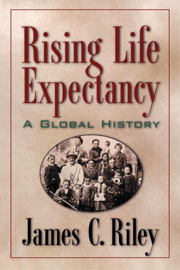Book contents
- Frontmatter
- Dedication
- Contents
- List of Figures, Maps, and Tables
- Preface and Acknowledgments
- Introduction: A Global Revolution in Life Expectancy
- 1 A Brief Overview of the Health Transition
- 2 Public Health
- 3 Medicine
- 4 Wealth, Income, and Economic Development
- 5 Famine, Malnutrition, and Diet
- 6 Households and Individuals
- 7 Literacy and Education
- Conclusion
- Index
Conclusion
Published online by Cambridge University Press: 05 February 2015
- Frontmatter
- Dedication
- Contents
- List of Figures, Maps, and Tables
- Preface and Acknowledgments
- Introduction: A Global Revolution in Life Expectancy
- 1 A Brief Overview of the Health Transition
- 2 Public Health
- 3 Medicine
- 4 Wealth, Income, and Economic Development
- 5 Famine, Malnutrition, and Diet
- 6 Households and Individuals
- 7 Literacy and Education
- Conclusion
- Index
Summary
Most people want to live a long life, although some hold out the reservation that the life they want to live should be healthy as well as long. It is not unusual for individual aspirations to conflict with the good of a society. In this case the two things align. Longer lives, especially longer and healthier lives, add much to the well-being of humankind. The individual's emotional life is richer for living long enough to get to know not just the next generation but one or two after it and for grandchildren to know their grandparents. Society benefits from the experience and the wisdom of older people. The rhythms of life are more predictable when the young live to be old. As they age, many people find that each new stage holds its own rewards and pleasures, which are seldom anticipated at younger ages. Living to be old in good or adequate health is, moreover, a form of freedom. It creates the opportunity to think, to read, to work, to love, to enjoy oneself.
The goal of “health for all by the year 2000,” set in 1978, could not be achieved. Each year in the early 1990s global deaths totaled some 51 million people. More than half of those deaths occurred in infancy, childhood, or early adulthood, at ages well under the life expectancy in any country. More than 12 million deaths occurred among children under five years of age.
- Type
- Chapter
- Information
- Rising Life ExpectancyA Global History, pp. 220 - 232Publisher: Cambridge University PressPrint publication year: 2001



